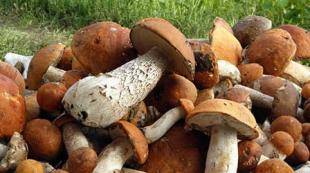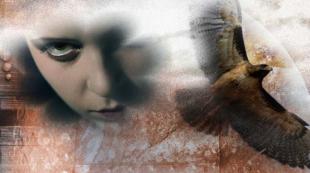Antique wood coloring: work technique. Aged doors: the fastest way to get the effect of antiquity How to give the effect of antiquity to wood
Antique wood products with a faded surface, textured notches and openwork grooves left by carpenter bugs are distinguished by special luxury and charm. It is clear that the natural aging process of wood takes long years. However, if desired, the tree can be aged artificially. There are several techniques by which you can give your new wooden things a spectacular antique look.
Chemical treatment is ideal for artificially aging hardwood:- To begin with, wooden blanks are thoroughly cleaned of stains and dirt.
- To make the natural pattern of wood more textured and voluminous, the boards are alternately treated with coarse and fine-grained sandpaper.
- Next, the polished wood is wiped with a rag or sponge soaked in ammonia or other alkaline solution. As a result of such simple processing, the workpieces acquire a noble darkening.
- Finishing varnishing with a transparent glaze will give the prepared wooden products a rich iridescent gloss.
- Cleaned from stains and dust wooden details burned with a blowtorch or gas burner until a slight soot appears.
- Next, the charred wood is manually processed with a metal / wire brush, after which it is cleaned with a fine emery cloth.
- To emphasize the beauty and texture of wood, products are covered with a stain of a neutral shade. To apply the solution, a soft, clean sponge is used, cavities and other hard-to-reach areas are painted over with a brush.
- The final stage of processing blanks is the application of decorative antique wax. The paste is rubbed into the wood in a circular motion using a woolen cloth.

- preparation of wood and rough selection of soft fibers;
- grinding and polishing workpieces;
- toning and varnishing of prepared parts.
An important nuance! For mechanical processing, it is recommended to use softwood with a pronounced patterned texture - pine, spruce, fir, larch, linden, ash or walnut.

- Before starting work, be sure to put on protective equipment: a high-quality respirator, plastic goggles and thick gloves will protect you from wood dust and flying particles of metal bristles.
- It is desirable to organize the workplace in such a way that the light rays are directed perpendicular to the wood fibers.
- In the process of work, avoid strong pressure on the surface to be treated, the pressure on the tool should be moderate.
- Before direct brushing, new brush heads must be “run in”, otherwise the wooden blanks will be covered with a small fleecy “terry cloth”.
- The movements of the brush should be directed along the hard wood grains; cross-cutting can spoil the natural beauty of growth rings.
On a note! For greater naturalness, the product can be decorated with "wormholes". To do this, with the help of a blunt core or an awl, shallow holes are randomly punched in the wood.
At the third stage of brushing, the wood is tinted. To give the blanks a natural, aged look, they are painted with stain or acrylic paint in dark shades. First, the selected paint and varnish is abundantly applied to the wooden surface, then its excess is immediately removed with a rag or rubber spatula. Thanks to this tinting technique, potholes and depressions acquire a rich dark hue, while the protrusions, the so-called "ridges", remain lighter. After complete drying, the products are coated with a transparent protective impregnation or acrylic varnish.To simulate the aging of wood, you will have to stock up on remarkable patience. Such work does not tolerate fuss and haste. However, the result is worth it - an artificially aged tree looks incomparably beautiful, spectacular and soundly.
How to make an aged tree at home and give it a vintage look with your own hands? This article is dedicated to just such tricks! Artificially aged things look very stylish and harmonious!
The 7 methods of aging wood with paint, which we will consider here, are interesting for their simplicity and excellent end result. They also do not require the purchase of any expensive special materials or tools.
We will analyze in detail the following 7 painting methods:
This is a versatile technique that helps to give wood or wooden furniture vintage look. It can be used on both raw wood and already painted wood and furniture. Suitable for painting in one or more layers.
For example, this is the result obtained when painting with this method in White color (detailed guide read the article "") 
Let's take a detailed look at how to paint a tree using this method, making three layers (brown, white and yellow).
Necessary materials:
- paint (brown, white and yellow)
- brush, candle, rag.
Step-by-step instruction:
Step 1: First coat of paint
- Decide on the color of the paint that you will take as a basis. This will be the first, bottom coat of paint, which we will apply directly to the tree. In this case, we use dark brown.
- Paint the wood with slightly chaotic strokes, without painting the surface completely and evenly.
- Leave until completely dry.
Step 2: Use a candle
Take a candle and rub it on the surface of the wood in several randomly chosen places(at the same time, press quite hard on the candle so that a clear trace of wax or paraffin remains on the tree).

- Step 3: Second coat of paint Choose a color for the next layer and apply paint (here we use white). At this stage, the paint can be applied evenly over the entire surface, and not in strokes, as with the first layer. Leave until completely dry.
- Step 4: After that, take a rag and wipe the surface, and with some pressure. Where wax has been applied, the paint will peel off the surface. If two layers are enough for you, then you can stop there, and if not, we move on.
- Step 5: Third coat of paint Repeat steps 2 and 3, but the last one is using a different color paint (here it will be yellow). After the paint has dried, you can apply a protective varnish. The latter is not necessary due to the fact that we specifically gave an old look, so if the paint starts to lag a little over time, this will not be noticeable.
2. Aging with wet paper
This method of giving the wood an aged texture is similar to the previous one with candles, only now instead of wax there will be wet paper(if suddenly there was no candle at home, then everyone certainly has paper).
Necessary materials:
- dye,
- brush, paper,
- a bowl of water.
Step-by-step instruction:

- Step 1: Attach the wet paper. Here, no base paint was applied to show the natural color of the wood. Therefore, we immediately take a sheet of paper, tear it into uneven pieces different shapes and size. After that, dip each piece in a bowl of water and place it on the wood you are going to paint.
- Step 2: Apply paint. Having laid out all the pieces of paper, immediately start painting in the chosen color, that is, you do not need to wait until the paper dries.
- Step 3: Paint removal Then carefully lift each piece of paper off the surface. You can do this while the paint is still slightly damp, or after it has completely dried.
You can make several layers, for example, as in the previous method. To do this, follow step by step instructions described there, replacing the wax with damp paper.
3. Texture with a dry brush "Loft"
This technique is great for creating an old and scratched look. The key to success here is just using a very dry brush. For example, old brushes with hard bristles are perfect.

Necessary materials:
- brush with stiff bristles
- paint on water based.
Instruction:
This is what the process looks like:

- Dip the brush in the paint of your chosen color and leave as little paint on it as possible.
- Apply paint with quick strokes in different directions. Be careful not to get carried away and cover the entire surface.
This technique is also suitable for loft metal effect painting, for example, to create these faux zinc letters.

You can also combine this method by using sandpaper to remove some of the paint after applying each coat.
4. Painting with scrapers in the style of Provence
The result will be about the same as when using sandpaper. The difference is that sandpaper not only removes some of the paint, but also smoothes the surface of the wood if there were bumps in that place (which is not suitable if you want to keep the structure of the wood, leaving it as natural as possible). The second difference is that sandpaper is used only after the paint has dried.


Necessary materials: brush, paint, scraper (or any unnecessary plastic card).

Instruction:
- First paint the tree.
- After, How does the paint dry a little?(not completely dry, just a few minutes when the coating has already formed, but still sticky to the touch), take a scraper or old plastic card and scrape off some of the paint in some places.
ADVICE: If you're painting furniture, scrape off the corners and edges of the paint, because that's where it's most likely to come off with use. Thus, the effect of antiquity will look more natural.
5. Rinse method
This method for creating the effect of old wood is suitable for elegant furniture in a rustic or Provence style. It is best used on raw wood.
Necessary materials:
- paint, brush,
- water, rag.
Instruction:

- Apply a layer of paint and let it dry for a few minutes (as in the previous method, so that it is still tacky and not completely dry).
- After that quickly rinse the wood with water by gently wiping the surface with a cloth. The goal is to wash off some of the paint on the surface. Leave to dry. That's all!
For example, a table painted in soft green, after applying this method, looks just fine.
6. Method of painting with wooden blocks
This is a simple method that allows you to age wood or furniture using a block of wood.
Necessary materials:
- paint, brush,
- wooden block.
Instruction: 
- Dip the end of a piece of wood into the paint and run it across the surface to be painted.
- Apply as many colors and layers as you like.
Here, for example, they made one layer of pale blue paint.
7. Paint pouring method
This is a one-step method suitable for all types of wood with large quantity textures on the surface.
Necessary materials: paint, scraper (or plastic card).

Instruction: You just need to pour a little paint on the surface of the wood and smear it with a scraper. Wait for it to dry and you're done!
After we've covered all 7 methods for painting antique wood, here are a few basic tips that you can apply to all methods:
- If the surface you are going to paint is was treated with a sealant, wax or varnish would be better polish it up a bit so that the new paint lays better.
- Feel free to experiment: you can mix and match these methods to create your own design style.
- At first practice on some piece of wood or on less visible areas of the furniture (for example, on the inside of a cabinet door to be painted) before working on more visible parts.
And remember that the main thing here is your desire! Good luck!

It's been quite popular lately. Antique interior items are very refined and beautiful, but not everyone can afford it, sometimes the price just rolls over.
Designers have long come up with ways to give new things an aged look without spending large sums of money. There are dyes for wood, antique metal paint is also done. So there is a choice in this matter.
Today we will talk about how to make antique wood and metal. Also on the video in this article and the photo you can get and Additional information which can make this job much easier.
Antique paint on wood is a way to turn the most ordinary things into a highlight of the interior and an object of admiration. You can paint any items: furniture, doors (see How to paint a door: we select an option) and decorative accessories.
Aged wooden and metal products look especially realistic. The choice of technique for creating the effect of aging is also unlimited. The most popular are those methods that allow you to realize the most daring ideas at home with your own hands.
Surface preparation
Any item that will be painted must be pre-treated.
We make the basis for applying the dye
So:
- First of all, the product is cleaned. Varnish, paint or any other coating must be completely removed (see How to remove paint from wood: do it the right way). Fittings or other interfering parts, if any, are also dismantled. They can also be aged or replaced with vintage ones.
- Then, to remove all major irregularities, the cleaned surface is ground first with coarse-grained sandpaper, and then finer.
- The already polished object is cleaned of dust and other contaminants, which may interfere with the uniformity of the future coating.
- The last stage of preparation is coating with an antiseptic primer. It will protect against rotting, mold or corrosion, and will also help the future paint to firmly attach to the product.
- Puttying small irregularities is not recommended.. And even vice versa. If the surface is perfectly flat, then small cracks and chips can be artificially added. They will give the future product realism.
- After preparation, you can proceed directly to the creative part. Be sure to experiment on less visible areas first to see if you like the result.
Modern designers offer many techniques for giving wooden products an aged look. For each individual item, you need to choose the most suitable method.
The effect of a dilapidated and shabby surface
This method is also called brushing. This is a fairly common method that is great for furniture or wood products.

In order for the wood to acquire a dilapidated and shabby look, it is necessary:
- Apply acrylic paint to the prepared surface and dry completely. It is better to choose matte shades, this will give the product the appearance of antiques that have been gathering dust on the shelf for many years.
- Create natural abrasions with fine-grained sandpaper or a metal sponge. Thus, the tree will acquire relief and texture.
- Clean the surface from the formed dust.
- Apply a second thin coat of paint.
- For a more vibrant faded effect, individual places can be further treated with abrasive material.
- At the final stage, go through fine-grained sandpaper over the entire painted surface.
To achieve this effect, it takes not so much time as labor, so that traces of decades appear on the tree in a short time.
Crackle technique
Another effect can be achieved with a special craquelure varnish. Under the action of the composition, a pattern of small cracks forms on the paint. The product takes on a sun-burnt appearance when the coating cracks and peels off. Craquelure is perfect for wood products, furniture elements and even for doors and glass.
If you use a special craquelure varnish, then you need to follow the instructions:
- A layer of paint is applied to the cleaned product. Cracks in the final work will be named after this background color.
- After drying, the product is covered with craquelure varnish strictly in one direction.
- The main color paint is applied on top. Under the influence of the finishing layer, thin cracks form on the surface.
- At the final stage, a transparent varnish is applied to protect the coating.
You can achieve the effect of cracks without buying expensive craquelure.
To do this, you need to follow just two steps:
- Cover the surface with any paint (except water-soluble).
- When the first layer dries slightly, you need to apply the base color acrylic. Due to the fact that the final layer dries faster, cracks will appear on the product, through which the base layer of paint will appear.
Attention: Craquelure as a way of decorating allows you to complement the interior with furniture and interior items in Provence or country style.
patina effect
Many antique metal objects acquire a specific blue-green coating. Due to the long-term influence of atmospheric precipitation, a patina is formed (see Patina paint for metal).

To achieve the antique effect, a special paint is used - patina.
To obtain high-quality coverage, the following conditions must be met:
- Initially, the wood is varnished. You should choose varnishes that form a film that makes the surface durable and wear-resistant.
- After drying, the product is covered with a very thin layer of paint with a patina effect.
- After at least 30 minutes, the entire surface is treated with a metal sponge or sandpaper. The stronger the treatment, the more pronounced the effect will be.
- Remove all dust with a dry soft cloth.
- Finally, varnish is applied.
Each product with a patina effect brings uniqueness to the interior and does not require special care.
color effect
Multi-layer staining gives wooden products a shabby look.
What is needed for this:
- It is recommended to artificially inflict all sorts of minor damage. In random order and at different angles, drill holes that imitate the moves of grinder beetles or bark beetles. You can beat off with a hammer, pierce with an awl, walk with a saw. The main goal is to give the wood the relief of antiquity.
- The surface is covered with a thin layer of paint of the main color so that the wood pattern shows through.
- Sandpaper or a metal brush creates abrasions.
- The second color is applied with light brush strokes. To increase the realism in places, you can shade the paint.
This method is based on the color and texture impression of old wood.
pollution effect
Many items in the process of use acquire natural scuffs, giving them an outdated look.
- To achieve this artificially is quite simple. In those places where there should be scuffs, hard wax is applied in one direction and with intermittent movements. Then the product is varnished.
- Dark wax, applied to the recesses in the surface of the tree, greatly increases the effect of antiquity.
Protection and care of aged items
In order for things created by one's own hands to please as long as possible, it is necessary to protect them from external influences:
- You can apply wax or wax-based mastic to the wooden surface. They will perfectly protect water-based paint from damage and extend the life of the product. Using a soft, dry cloth or sponge, evenly cover the object with wax and rub it if necessary.
- If the surface of the object is going to be used extensively, then in addition to waxing it is necessary to cover the wood with a matt acrylic lacquer. It will need to be updated over time.
- Aged items do not require special care. They must be wiped with a damp, lint-free cloth, and to add shine, use special means for polishing.
Attention: Proper protection and care will help to keep the product, and it will please the creator for a long time.
metal aging
Many people make products from metal. But not always a modern product can fit into the overall interior of the building. This is especially the doors and gates (see Painting the gate: instructions). Here, too, it is quite possible to give the effect of antiquity. These are either dyes for bronze, or giving the effect of aging metal.
Imitation of expensive metal
Items made of precious metals make the interior sophisticated, but not everyone can afford them.

Modern stores offer a wide range of paints with imitation of bronze, silver or gold. They are safe, easy to use, withstand high temperatures and protect the substrate from rust.
Metal products can be painted in one tone, or you can try to achieve a deeper coating:
- Initially, all contaminants are removed from the metal product and degreased. Then comes the primer treatment. This will improve the quality of adhesion to the base color.
- With one-color staining, you can immediately cover the product with metallic paint in several dense layers.
- If you want to achieve the effect of antique metal, then after a single coloring, all the recesses are tinted with a darker paint. After complete drying, you need to give the product a worn look. To do this, light paint is applied to all corners and protruding parts with a dry brush. Shuts down top coat transparent varnish.
antique metal effect
Many decorative styles suggest the presence of interior items with traces of time. Antiques are very expensive and require restoration and special care.

The best way out of this situation is to independently create the effect of aged metal:
- On a dry and clean prepared surface, preferably with a brush, metallic paint is applied with careless movements.
- After drying, the product is evenly coated with a craquelure primer. During drying, a transparent polymer film is formed.
- At the final stage, craquelure is applied, which will add cracks and give the object the appearance of an old, corroded material.
What way to age objects is not chosen, the main thing is that the finished product brings joy and harmoniously fits into the interior.
Antique brick paint is applied or antique wood is painted, the preparation of the plane is extremely important. Only then will the dye lie down evenly and efficiently. The instructions will help you avoid mistakes in this work.
Learn how to age a tree with your own hands in a loft style at home with your own hands and you can use it anywhere in production: for wooden kitchen, Provence furniture, tables, etc. It turns out a wonderful color that will decorate the decor of any home! The use of modern wood in the design is, perhaps, a win-win option.
This is an incredibly attractive, breathable, pleasant to the touch natural material. It favorably affects the formation of the microclimate in the home, has bactericidal properties, and is useful for human energy. In any room, wooden ceiling beams, individual decorative elements will look great.
This wonderful material lends itself perfectly to the most different types processing: It can be left natural, dyed, aged, and more.
There is no specific, unambiguous answer to this question.
This procedure is carried out for various purposes, most often it is:

How to make a tree old: brushing
There are many various ways for processing the tree, allowing you to get the desired result. Brushing, or texturing, is one of the most widely used.

The word brush is of English origin and means a brush. From him came the name of the technique, which consists in using the mentioned object to remove soft pliable fibers of the material. Very similar processes occur as a result of natural aging, but in this case they take a fairly large amount of time. This method is considered the closest to the natural natural changes that occur with the material.
With it, the wood acquires a distinct woody texture.
What tree can be aged: breeds
Give surface wooden material an aged look with the help of brushing is quite possible on your own, at home. The problem is that not every type of wood is suitable for such processing.
Maple, cherry, beech, pear, certain varieties of exotic plants are not amenable to this method of aging.
 It is not suitable for products and surfaces made of MDF. What to do if not available suitable material? We'll have to use a different method, chemical. The wood of coniferous trees is best processed mechanically.
It is not suitable for products and surfaces made of MDF. What to do if not available suitable material? We'll have to use a different method, chemical. The wood of coniferous trees is best processed mechanically.
Brushing is a rather laborious procedure. Main tool for its implementation - an elastic and durable metal brush. Quick change appearance a tree with its help will not work, so you can speed up the process.
To do this, you need a grinder or a drill with a special brush made of hard wire.
It should be noted that the use of electromechanical tools for woodworking can be very unsafe. The fact is that quite strong vibrations occur during the event, which can cause separation and sharp flying away not only of wooden chips, but also of metal elements.
Therefore, it is important not only to know how to age a tree, but also to be able to do it safely, without risking your own health. All activities are carried out in a special protective suit, eyes must be covered with camouflage goggles or a face shield. The airways are closed with a special respirator.
Chemical treatment during aging
 Is it possible to age a tree by hand without the use of special devices and tools? Coarse-grained sandpaper is required, with which the surface is cleaned. On the prepared material is applied ammonia(ammonia solution), from which the tree becomes noticeably darker.
Is it possible to age a tree by hand without the use of special devices and tools? Coarse-grained sandpaper is required, with which the surface is cleaned. On the prepared material is applied ammonia(ammonia solution), from which the tree becomes noticeably darker.
Thanks to this treatment, the wood texture becomes more distinct, while the noble darkening gives the material a touch of exquisite antiquity.
Such processing can be superficial, fairly light in nature.. In this case, a non-coarse polymer brush is used. If the tree is subjected to deep processing, then even the annual rings of wood become noticeable.
 Chemical method
Chemical method The main thing is not to overdo it when performing this operation. Otherwise, the result of the efforts expended will not be elegant textured surface, but loose indeterminate wood.
Regardless of the chosen processing method, after a rough initial cleaning, the wooden blank must be restored to its original aesthetics. Irregularities and burrs are carefully removed from the surface of the object, then it is removed with a special abrasive brush. Then the material is additionally lightened and glossed with fine sandpaper.
Aged wood effect: patina
Mechanical processing alone is not enough to obtain the desired effect of aged wood. What to do with the material next? You can cover the product with one of the types of varnish. The material looks very interesting after a special treatment - patination. It allows you to make the surface of the material even more embossed. Patina is a peculiar, unique gloss acquired by the material over time.
 Applying patina: the process
Applying patina: the process His own recreation requires considerable effort, and is carried out in several separate stages. What is the patination process?
This is the application of special stains and compositions to the treated surface. In each case, they are selected individually, in accordance with the desired shade and color of the product.
The compositions should be applied in such a way that they find themselves in the pores of the wood, which open during mechanical processing.
The essence of this method is to make the deep pores of the material appear contrasting and dark against the general background, which is lighter. To carry out this procedure yourself, you need to choose a paint that matches the color. She completely stains the prepared surface, and, without waiting for complete drying, remove part of the top layer with a cloth or sponge. Such wood looks noble and looks like an old one.
But patination is not the only way to get the same or similar result. It is absolutely wonderful to age products with the help of special enamels. This method will allow you to get a real work of art, outwardly not much different from genuine antiques.
 A layer of enamel of a certain color is applied to the surface. When it dries, it will be the turn for the next staining. For secondary application, a composition of a different shade, and a more liquid consistency, will be required.
A layer of enamel of a certain color is applied to the surface. When it dries, it will be the turn for the next staining. For secondary application, a composition of a different shade, and a more liquid consistency, will be required.
When the treated rock is completely dry, its surface is easily processed with sandpaper. AT separate places the initial layer appears, forming elegant scuffs.
Toning and varnishing
The patination process must be completed with tinting. To carry it out, you will need special formulations that contain resins and natural ones. As a finish, a coating of treated wood with a double or triple layer of varnish is used. After drying, the surface is treated with a soft cloth to give a special shine.
 Such varnishing fixes all previous manipulations, gives the product a finished, finished look.
Such varnishing fixes all previous manipulations, gives the product a finished, finished look.
And although the process is quite complicated and time-consuming, anyone can master the art of working with wood.
The main thing here is to carefully study the technology, understand the sequence of stages, and strictly follow the instructions.
Secrets of high-quality brushing: how to age a tree
How to correctly carry out the brushing process so that the result is pleasing to the eye? You need to know some of the nuances of the process.

Aged wood: use in the interior
 Wood treated in a special way can not be found in every dwelling. The fact is that it is not enough just to age the wood.
Wood treated in a special way can not be found in every dwelling. The fact is that it is not enough just to age the wood.
The ability to correctly use it for interior design is of great importance. But the use of the described method of brushing allows you to make completely unique products, in fact exclusive.
These can be individual pieces of furniture, or entire sets and sets.
Chests of drawers, candlesticks, bookshelves, antique sideboards, frames for mirrors and paintings, country furniture and kitchen sets look especially interesting. This method of processing wood is great for the manufacture of individual doors and partitions.
The method of wood brushing is excellent for giving special effect to sexual and parquet board. Often, such material is used for the author's decoration of the walls of saunas or home baths, billiard rooms, retro cafes, bars and non-standard rooms.
Choosing the appropriate design of the room, it has become fashionable to give wood products the effect of antiquity. There are several technologies that will visually add age and make decor details uniquely handmade.
They are easy to use, so you can do it on your own, saving money from the family budget.
Why is this kind of processing necessary?
Whole the world human is filled with electronic assistants, artificial materials. Under these conditions, it is not surprising that among urban residents it has become popular to use wood in interior design in order to get a little closer to nature.
Carrying out the processing of antique boards or timber, the owner receives an exclusive product, because each tree has its own unique relief.


In addition, the aging technology significantly increases the strength of raw materials, in contrast to the natural effects of the environment and time.
And thanks to the coating of wood with protective solutions and varnishes, its service life is extended, in addition, paint or varnish prevents insects from entering, and prevents the process of wood decay.
This kind decorative finishes used for ceiling beams, laying floors, furniture.

However, it is important to understand that not all lumber is suitable for this type of work. You can not use the aging technique for the following types of wood:
- cherry, pear (other fruit species);
- maple;
- alder.
Therefore, for semi-antique wood processing, it is better to purchase hardwoods, perfect for:
- nut;
- ash;
- larch;
- pine.
And after performing a high-quality tinting of the product, you can get an imitation of an expensive type of wood, taking as a basis a budget-priced pine or ash tree.
Important! Old trees require more careful processing, as they have many layers with different densities. Therefore, in order to accurately determine the age of raw materials, you need to pay attention to the number of rings on the cut: the more there are, the older the tree.
What methods of aging should be paid attention to?
You can create antiques from furniture in three ways, these include:

But also patination of wood is also distinguished, when special paints, wax or stains are applied to the raw materials in several layers, which, being absorbed, visually give the surface of the product an age.

Masters who will practice such an imitation for the first time with their own hands are recommended to practice a little on pieces of boards or timber in order to clearly understand all the nuances of the process.
It should be noted right away that if it is necessary to process the finished product, then it would be correct to initially disassemble it so that the entire surface has a uniform coating.
And to create an author's masterpiece, you should pay attention to wood slightly damaged by insects, the external environment, where there are knots, chips, because in the end such a product will look luxurious. Therefore, it will perfectly complement the kitchen, veranda, living room in the style of "Country", "Provence".
Thematic material:
mechanical way
This type of aging is called wood brushing, since brush in translation from English is a brush. It is this building element that performs the bulk of the work.


With the help of brushes, soft layers are removed from the surface of the wood, and the material acquires a relief. However, the desired effect will be obtained only when the cleaned raw materials are treated with paint or varnish, emphasizing and giving contrast to the pattern.
Important! For brushing, it is necessary to choose a tree with a clearly defined fibrous structure, otherwise the whole processing process may come to naught.
To carry out this method of aging, you need to have the following tools at hand:
- Bulgarian;
- electric drill;
- hard and soft metal brushes;
- sandpaper;
- paint brushes;
- stain;
- acrylic paint;

And in order not to harm health, all operations must be performed in an open space, adhering to safety rules.
Important brushing steps
Mechanical aging simulation consists of 3 main steps. Among them:
- Chernova. A nozzle made of a metal brush in the form of a circle is installed on the grinder. The surface is processed along the fibers, while the pressure of the hand should not change so as not to damage the relief of the material.
- Finishing or grinding. The electric drill is equipped with a brass brush, a grinder with a less rigid metal brush is also suitable, while the rotational speed of the tool must be reduced. The entire surface is processed, as a result of which various burrs, roughness must be eliminated. And in order for the wood to become pleasant to the touch, it is better to go over the top with sandpaper a couple more times.
- Coloring and polishing. The final step, thanks to which the product acquires the expected antique look. A layer of stain is applied to the material, then gently washed off with a rag, due to which only soft parts of the raw material acquire color. If desired, you can add paint in bright colors. After drying, the wood is polished and varnished.

An option for aging products can be the use of craquelure varnish. After applying this varnish, cracks appear on the surface, into which paint can be rubbed and the raw material acquires a contrasting pattern.
wood burning
Impact high temperature fire on raw material allows you to achieve the effect of antiquity in a short time.
As a tool, it is better to take a gas burner, since the blowtorch will smoke a lot, which can ruin the surface to be treated.


Operating procedure:
- The material is burned by the burner to a depth of 3 mm evenly over the entire area. In this case, you should carefully watch so that the tree does not catch fire.
- The charred layer of raw materials is removed with a metal brush.
- The surface is polished with sandpaper.
- Painting in this case is not necessary, you can simply apply a clear varnish to the product.
But you need to understand that firing indoors is prohibited and life-threatening.
Chemical method
If you decide to use this treatment method, you should immediately stock up on rubber gloves and a protective face mask so that the toxic fumes from the solutions do not cause poisoning.
Alkalis, such as detergents, are suitable as a base substance cookers. The tree is covered with a solution in several layers and left for about 12 hours, no longer, depending on the substance and type of wood. Then it is thoroughly washed with a solution of vinegar. Its concentration is not more than 1 tsp. for 200 ml of water. When the surface dries, it must be sanded. applied to the treated material acrylic paint or varnished.
How much does wood aging cost?
The average price for brushing is from 350 to 1 thousand rubles per 1 m 2. The cost of services depends on the region, breed and size of the material. For example, processing 1 m2 of unpainted hardwood boards will cost 50-100 rubles more than the same lumber from pine or spruce.




If the client wants to immediately order the painting of raw materials, then the cost of work can be safely multiplied by 2. The consumer can find photos of the services offered on any website of the enterprise of interest.
Of course, the prices for such an imitation of antiquity are high. So you can stock up necessary set tools, patience and make an antique wooden masterpiece at home, the quality of which will not be inferior to factory counterparts.









